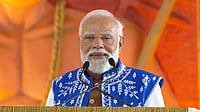Infrastructure & Investment
Infrastructure projects and investment announcements have been prominent. Specifically, NHAI has unveiled 55 highway projects, signaling a focus on improving
road networks. A luxury tower project in Mumbai, with an investment of Rs 700 crore, shows confidence in the real estate sector. Simultaneously, NBCC secured a Rs 500 crore contract from Damodar Valley Corp, demonstrating continued government spending in infrastructure development. Furthermore, the CCI has planned investment of Rs 700 crore for a luxury tower in Mumbai, reflecting further developments in the real estate sector and the growth of urban infrastructure. These projects underscore a broader strategy of stimulating economic activity and providing opportunities for businesses and investors.
Trade & Export Dynamics
Trade figures reveal a complex picture, including the recent dip in India's exports to the US, which highlights the impact of tariffs and evolving trade policies. However, there are also opportunities, as US tariff cuts are expected to benefit India's agricultural exports, opening new avenues for growth. Gold imports saw a surge, reaching a record $14.72 billion in October, which points to consumer behavior and the global economic outlook. Moreover, discussions between India and Russia on maritime cooperation in Delhi signify efforts to strengthen international trade relations and diversify partnerships. These dynamics reflect both challenges and opportunities as India navigates international trade and seeks to expand its economic influence.
Market & Sectoral Movements
Several sectors are demonstrating varied performances. The gold market shows an upward trend, with prices rising amid global cues, possibly influencing investor sentiment and consumer behavior. The surge in gold imports to $14.72 billion in October signifies consumer spending trends. Meanwhile, the Power & Instrumentation (Gujarat) Q2 profit has surged, showing strong growth. Further, the news of Exide planning to begin lithium cell production by the end of FY26 underscores the rising importance of sustainable energy and the shift towards green technologies. These sector-specific trends reflect a dynamic economic environment, highlighting both challenges and success in different areas of the Indian economy.
Regulatory & Financial Aspects
Significant developments are occurring in the financial and regulatory arenas. The DEA Secretary emphasized the need to harmonize regulations to attract investors, which is crucial for fostering economic growth. Sebi aims to double equity investors in 3-5 years, a move intended to boost market participation and confidence. The Finance Commission submitted its report to the President, which will likely shape fiscal policies. Additionally, the government has set forth guidelines for the export promotion mission rollout, streamlining procedures to assist businesses and ease market access. These developments reflect a concerted effort to improve the investment climate, simplify business operations, and bolster economic expansion.
Emerging & Innovative Sectors
Several announcements are pointing to growth in new and innovative sectors. Infosys is deploying AI models to transform GCCs into innovation hubs, promoting the rise of artificial intelligence in business operations. HCLTech and Nvidia launched an AI innovation lab, suggesting the rise of collaborative ventures in the tech sector. Furthermore, the Indo-Japan Auto collaboration focusing on GST 2.0 and reforms demonstrates efforts to streamline processes and strengthen international collaboration. Zetwerk's ECMS approval for a PCB and transceiver project highlights the importance of the electronics manufacturing sector. These instances highlight India's move toward modernization and innovation, as well as the importance of global collaboration.














